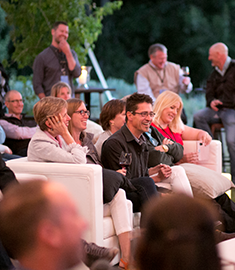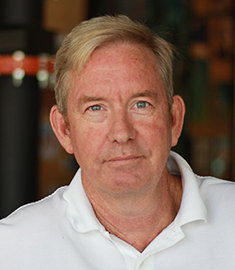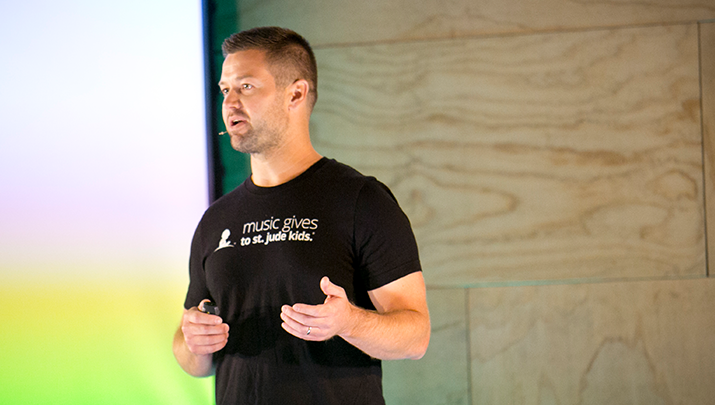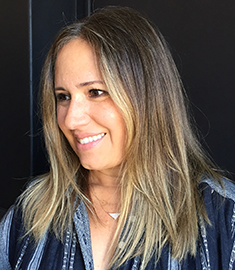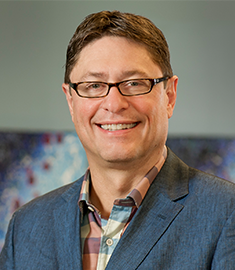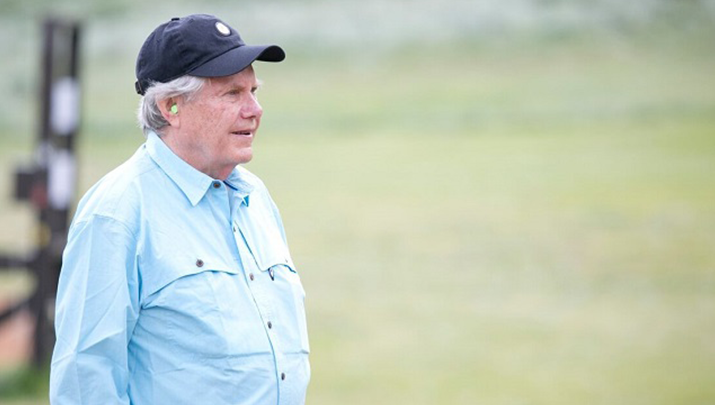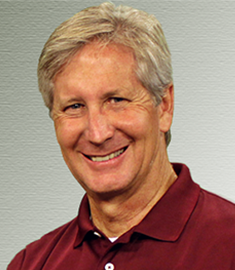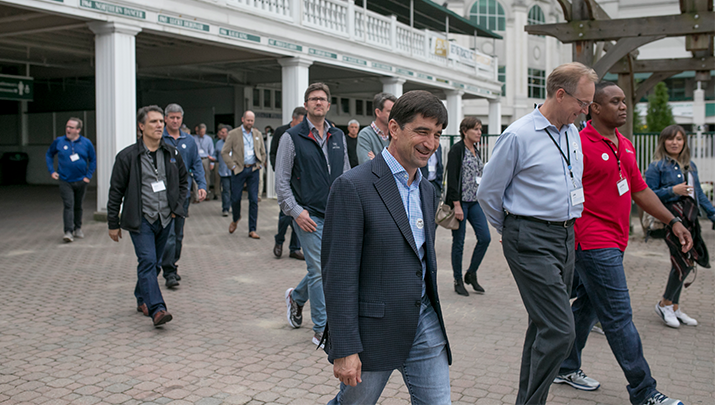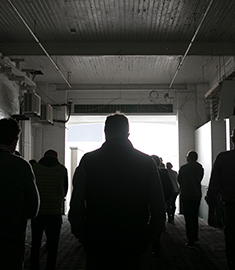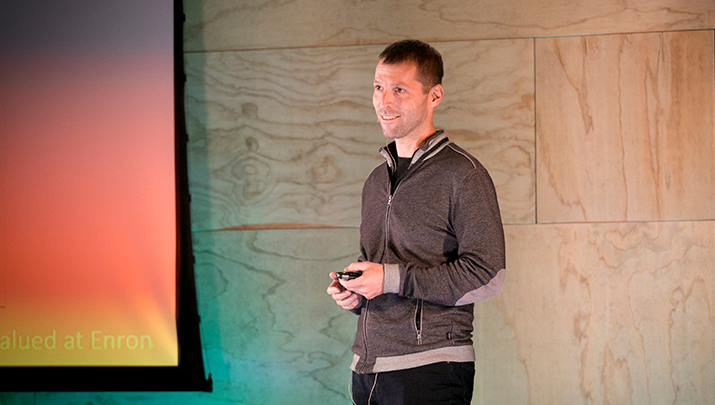New Year Letter From The Tugboat Team
Dear Evergreen Journal readers,
We hope you had a wonderful holiday season and are excited for 2018! Thank you for supporting the Evergreen Movement.
Reflections on the Past Year
Tugboat Institute membership grew 40%, expanding the footprint of our group across new geographies, industries and company sizes. This paced growth keeps our community vibrant and brings new ideas and wisdom to bear.
For me, the Tugboat Institute Summit 2017 in Sun Valley was our best one yet. I attribute it to the authenticity, curiosity and selfless giving of our members. It’s truly what distinguishes our group. Of course, the talks, outdoor adventures, food, drink and celebration were exceptional and icing on the cake. A warm thank-you to members who shared their stories and best practices with us from the stage: Chip Dickinson, Bob Glazer, Stella Ma, Robert Pasin, Joe Reynolds, Jess Rovello and Jed York.
We tried a different format with Tugboat Institute @Louisville in October. It was curated and led by growth expert Professor Ed Hess and used a mix of homework, lectures and peer workshops. A special thank-you to Carrie Van Winkle Greener and her family for the tastings, and Aric Andrews for Churchill Downs. Both made the experience feel extra special and intimate.
Our small and mighty team grew in 2017. We welcomed Maria Hilton to the member relations team.
Through the Evergreen Journal, we chronicled 27 Evergreen CEO stories and best practices, and shared 15 talks and videos. Participating in our Evergreen Journal is one of the most tangible ways our members contribute to the broader community and Evergreen Movement — a heartfelt thank-you to each and every one of our authors and speakers.
Key Gatherings in 2018
Tugboat Institute Summit 2018 will take place in Sun Valley in June.
Our Fall Exemplar event returns to our roots and befits the name. Tugboat Institute @Enterprise will be hosted by Enterprise Rent-A-Car Chairman and CEO Andy Taylor and his daughter, Chrissy Taylor, at their headquarters in St. Louis, Missouri.
Small Improvements
You will see a few changes in the new year. First, we have redesigned several of the key pages on our website. Please take a look!
In a shift in philosophy, we want to prioritize easy sharing of Evergreen Journal content over driving traffic to our website. This includes a new format for our EJ newsletter that is easier to read and forward, and more share buttons on our EJ content. When you read or watch something you enjoy, please take an extra moment to share with your network, whether by email or social media. Lastly, at the end of Q1, we will be mailing out our first Evergreen Journal quarterly print publication, which will highlight the articles and talks from the prior three months. For those who like old-fashioned paper, this will be a nice read and something to pass around, too.
We want the world to be exposed to the inspiration, ideas and best practices in the work, family and life of our Evergreen community. If you have other ideas for us on how to do this better, we are all ears!
Final Thoughts
Every year offers the opportunity to reflect, adjust and be better. My team and I will strive to learn, improve and grow in work and in our lives. And we hope for the same for you, your company, your family and your community. All of us contribute to making our society better for everyone.
With Gratitude,
Dave Whorton & The Tugboat Team
Get Out of the Office
Over the years, I’ve seen a pattern: entrepreneurs who keep pushing to grow even when that growth isn’t healthy for the company. It’s not surprising — like the Geico ad says, “If you’re an entrepreneur, it’s what you do.” This is a behavior I’ve had to guard against myself. One of the things I do is cultivate personal interests outside of my company. Today I chair our city’s economic development board, I mentor a few younger founders and I helped start a nonprofit that recently purchased a tall ship for our city. These activities absorb plenty of energy, allowing me to pursue a more thoughtful growth path for our small restaurant company.
It took me a while to learn that lesson — that fast growth is not always good or healthy. In my 20s and early 30s, I thought you should always grow a company as big as it can get. If not for a more cautious partner, I probably would have grown our first company right into oblivion.
Then in 2000, I founded Fishbowl, a customer engagement platform. Software is a different world, where you really do have to grow or die, especially when your competitors are very large, fast-growing companies. Taking venture capital money and joining the race was the right strategy for us, and it paid off when we sold the company to a Silicon Valley private equity firm. But it still never felt right to be planning an exit. That was at odds with the elements of a great company — a long-term vision, a worthwhile purpose, a focus on people and a clearly articulated culture.
So for my next act I returned to my roots, joining forces with two former restaurant colleagues. Our new company is small by design, a collection of six unique concepts located close to one another. This hyperlocal strategy lets us leverage our customer base, provide more career opportunities for our people and stay close to our operations. Even our name is intentionally limiting: Alexandria Restaurant Partners. When national developers call, I politely tell them to look at my business card.
Staying small does not mean opting out of growth, though. One of my heroes in the restaurant business is Joe’s Stone Crab, a family-owned business in Miami Beach that resisted opening more locations for its first 75 years, and then opened just three more in the next 25 years. Slow growth? Not at all. They bought the city block they sit on, expanded the original location, added a huge takeout operation, grew a fleet of ships to make sure they had a reliable supply chain and began shipping stone crabs in the pre-internet era. They are a private company, but are reputed to do over $30 million a year with very high margins.
The Joe’s Stone Crab lesson is that there are always ways to grow your business organically, by focusing on what’s right in front of you. And those opportunities are usually the best ones. We tried this ourselves a few years ago, opting to renovate and expand one of our restaurants rather than using that money to open a new one. We spent $1 million and now generate over $500,000 in additional profits annually. A pretty good financial return, but the real payoff was in strengthening the underlying business.
At the end of the day, growing a business should be fun. It’s about making things happen, and working with people you like and respect. Size doesn’t really matter here. If anything, it gets less fun as you grow bigger. It took a while for me to see this, but I’m glad I did. And I’m glad I’ve cultivated outside interests. They are just as challenging and often as fun as working in my own company. But I also think they are the key to helping our company grow at its appropriate Evergreen pace.
Scott Shaw is the partner at Alexandria Restaurant Partners.
Purpose on Purpose
If you’ve ever participated in Warrior Dash or a Firefly Music Festival, you have Joe Reynolds and his team to thank. In 2007, Reynolds started Red Frog Events from his apartment with the goal of delivering amazing experiences to people. While Red Frog does this well, the team is about more than just providing entertainment — it’s a vehicle for making a positive impact on the world. In 2013, Red Frog Events committed to raising $25 million for St. Jude Children’s Research Hospital, and as of 2017 has already achieved over 50 percent of that goal.
In his inspiring and moving talk, Reynolds shares how his commitment to St. Jude has helped drive his business while inspiring in his employees a larger Purpose.
Quality Reigns With Paced Growth
I founded my company, Ingrid & Isabel, 14 years ago with one simple product: the Bellaband. When I was pregnant with my daughter Isabel, I hit a point all pregnant women hit — I could no longer button my jeans. But instead of buying a bunch of maternity pants, I fashioned the first Bellaband, an elastic band that let me keep wearing my pants without having to button or zip them. Because it was such a common problem, my friends started clamoring for Bellabands. Today, we have sold millions of maternity bands, holding pants up worldwide.
But companies can’t exist on one product alone. That’s called a one-hit wonder, and I wanted to build an Evergreen business that would last for generations.
Retailers typically look for trends so they can capitalize on them by selling mass quantities quickly. But my prior work experience was at advertising agencies and marketing departments at tech startups, not in retail. Both of these careers were grounded in research and development, so I intimately knew the value of product prototyping and testing among your customers, as opposed to rushing to market.
So instead of reacting like a fast-paced retailer, I acted like a marketer and embraced the Evergreen principles of Pragmatic Innovation and Paced Growth. This choice defines us as a company and a brand.
Our revenues are up about 40 percent this year alone. We’re doubling the size of our staff. And as of July, we have a new exclusive maternity collection for Target, after being on a small portion of their floor since 2008.
But it wasn’t always easy. I passed up many quick-hit trends, like faux-denim ripped jeggings, in favor of Paced Growth, sometimes spending years market testing products on pregnant women.
For new items, like a nursing bra, we go through several stages of research with hundreds of moms. We interview them about their current garments, we have them bring their old nursing bras into our office and show us what they like and don’t like about them, then, we design to her issues. Everyone in my office tries on our prototypes before we ask more women to come in, try on, take home and wear repeatedly for weeks, washing and living in our samples. Then we get their honest feedback. It took us three years to develop a nursing bra we felt confident would work. In comparison, large companies in this category may take about four months to produce a new item.
The result is high praise from moms.
Keeping a close connection to mom has also yielded ideas for new products — like the Afterband. Postnatal clothing is a very crowded marketplace, and we didn’t care for the tone of that space — rushing mom into being small again, being sexy again, and doing it faster with corseted garments. From our research, we knew mom really well and had a hunch that these products and this attitude couldn’t be sitting well with her.
And we were right! Our deep tests revealed she despised most of the postnatal garments on the shelves, but was so overwhelmed with a new baby, she would never return them. Therefore the market stayed stagnant. We went to the drawing board and spent three years developing an entirely different band that appreciates mom’s time to heal and her need for support. Our Afterband grants her the patience to recover from pregnancy at her own pace. And it’s working. Sales are strong and mom’s comments are outstanding.
It’s pricey and time-consuming to do all this research and development. But the commitment pays off, and I’m always glad we do this work regardless. When we launch something, I need to feel absolutely secure it’s the right item for the current batch of pregnant women who are our customers. Perhaps we don’t produce as many items as larger companies, but every single one has been created with a bespoke mindset.
Being Evergreen allows us to be patient in developing the deep market insights and internal capabilities that I know we need in order to grow a sustainable company. If I’d had investors, I’m confident they would have encouraged me to rush our Target partnership years ago, or forced me to take on other significant partnerships to drive short-term revenue growth. Our offerings, and our company, wouldn’t have been ready. Thanks to our practices of Pragmatic Innovation and Paced Growth, we are now.
At the end of the day, I want to make sure our customers know that ours is a company that really cares about mom. She inspires us, not the marketplace.
Ingrid Carney is the founder and CEO of Ingrid & Isabel.
Fighting Back with Purpose
It took getting removed as the CEO of my own company for me to truly comprehend what my team and I needed to thrive. With more than a little grit and humility, I was able to Persevere through that difficult period and eventually return to grow my marketing communications firm, Firespring, into the Evergreen company it is today.
Before I founded Firespring, I launched an AlphaGraphics franchise in 1992 in Lincoln, Nebraska. I encouraged the franchisor to embrace the early promise of website design, making ours the first franchise to open a dedicated commercial website division. When one of my team members had a lucky encounter with the Backstreet Boys at the running of the bulls in Spain in the mid-1990s, we landed the boy band’s website design. Suddenly our website business was flourishing.
Building upon our success, in 2001 I bought out our franchise agreement with AlphaGraphics and launched Firespring (then named Digital IMS) as a website design and software-as-a-service company. I raised about $5 million in venture capital and expanded into 10 cities. We experienced explosive growth, closing one out of every three demos — and then everything fell apart.
After 9/11, everyone began cutting back, and suddenly we couldn’t get face time with prospects. Our close rate changed to one in 10. I made a lot of mistakes before and after that period. One was taking in capital without protecting myself and my employees. I had given too many of our board seats to institutional investors who now wanted immediate change. They wanted us to do more one-off custom work that would bring in fast money — business I’d always rejected because it’s not sustainable. They wanted us to stop serving nonprofits — a slice of our business that wasn’t incredibly profitable but gave us a strong sense of Purpose.
And in 2002, they ousted me as CEO of my own company. I remained on the board as one of seven directors and was assigned to a leadership committee of three people tasked with making decisions on behalf of the company. While I was still the majority owner, investors were essentially controlling every decision.
I had a brief moment where I thought about giving up. But after hitting that low, I gained clarity on what I believed the company should become.
I wanted a company that prioritized meaningful impact and sustainable profitability over chasing revenues for growth’s sake. And I believed we could become that company. I met with my team and apologized for letting them down. I told them I was going to fight for this new vision. We would have a greater focus on nonprofits. The switch would mean less revenue but a leaner, healthier company with a clear Purpose. Given our struggles, employees could have easily left the company and doubled their income. But they were moved by our new vision and stuck by me, even when I wasn’t sure yet how a plan would unfold.
Over the next five months, I swallowed my pride and pleaded to my family and a few friends for loans to buy out our investors. What made it feel worse was my asking them to help fix my mistakes. But it was worth the humility. Taking six months, I was able to regain control of my board and step back in as CEO of our nearly financially devastated company.
Of the 35 employees who were at Digital IMS when I was removed as CEO, 31 remained and stuck by me. Each of these employees took a 50 percent pay cut, and some deferred even more. I launched an open-book system, and together we worked to focus on securing consistent, steady clients and more nonprofits. These nonprofits paid less than companies looking for big creative projects but they gave us consistent monthly revenues supporting our move to Paced Growth. In 2004, we had not only turned the tide — we actually generated a net profit of more than $1 million. And in 2007, we changed our name to Firespring to better promote a national brand.
Today we are a company of nearly 250 people and have more than 9,000 clients in 12 countries and in all 50 states. Inc. magazine named Firespring one of the top 50 places to work in 2016. And we’ve donated millions of dollars to nonprofit organizations. In 2014, we became a B corporation to strengthen our mission to “leverage our people, products and profit as a force for good.”
My path has been one of Perseverance, but it’s also been about the importance of Purpose to our people, and just how loyal and amazing they are if you do the right thing. Nearly every employee who stayed with me during that troubled time in 2002 is still with Firespring today. Together we’re building a strong Evergreen company that makes us all proud.
Jay Wilkinson is the founder & CEO of Firespring.
How High-Performance Leaders Achieve Remarkable Results
W. Grant Gregory is the retired chairman of Deloitte & Touche and founder of DoubleClick. His success long preceded, and continued after, DoubleClick’s sale to Google in 2007, which he attributes to the high-performing teams he assembled and led. But how does one learn to identify talent that will thrive and excel? For Gregory, it meant understanding the key traits of the top performers in that particular role, and being absolutely focused on hiring talent with those traits.
In his Tugboat Institute Summit talk, Gregory describes how Don Clifton, his longtime mentor and the creator of StrengthsFinder, helped him adopt principles of positive psychology and strength-based leadership in the identification and development of talent at scale across large and complex organizations.
Three Brothers United Through Division
My two brothers and I inherited my father’s Texas-based pest-control company in 1987. We are as close as three brothers can be. Every day I am on the phone with or emailing them. We share information and ideas and marketing tips at regular meetings at our family ranch in Marble Falls.
What we don’t share is money.
That’s been the key to making ABC Home & Commercial Services work in its second generation of leadership. Family was always our No. 1 priority. So when my father decided to pass the company on to us, he needed to find a way to keep us equal — but he didn’t want to see us fighting over finances. In order to do this, he had to get creative about dividing up his company.
ABC was originally a one-man, one-truck gig that my father bought in 1967. He built up his business in San Antonio and eventually launched franchises in five other cities around the state. When he decided to retire, he sold all of the franchises except three: Austin, Houston and Dallas. He gave these remaining franchises as separate corporations to each of his children, and he remained part owner in all three.
It was an out-of-the-box idea that has worked out surprisingly well — and one that Evergreen companies might want to consider since succession is often a big issue. We brothers work together to ensure consistent quality across the company. If you go to our website, you can plug in your location and that will take you to the specific page for whichever brother is operating there. Over the years, ABC has evolved and branched out into lawn services, security systems, pool maintenance and even HVAC repairs. But we’ve each grown our businesses in ways that make sense for our particular regions. So my company in Austin might not have every service that my brothers offer elsewhere, but if the demand is there, we can ask each other for support on how best to grow that department.
We’ve also been careful not to steal business from each other as we’ve grown. My brothers and I literally have a map of the state of Texas with lines drawn for where each of us can expand in an equitable way. I have central and south Texas. That’s how we keep the peace. We have a saying for this: “Thou shalt not cross into your brothers’ territory or you shall have to deal with Mom.”
We share strategies for growth for the upcoming years, and we love to compete with each other on our P&L sheets. But we’ve all managed to grow without any serious interfamily feuding, which has helped in business and in our personal lives.
But now I’m faced with my own succession challenge — one I hope I can solve as creatively as my father did. Unfortunately I can’t just steal his ideas.
I have three children of my own, who are now grown and considering getting into the family business. My slice of ABC is a lot bigger than what my dad handed down to us, and a heck of a lot more complex because we now have so many new lines of business. There would never be a simple way for me to divide it into three distinct markets.
My plan right now is to give each of my children a third of the business. At this time, I don’t know what shape or form this will take. I also don’t know if it will allow for the kind of family harmony my brothers and I have been lucky enough to experience. We are working together to figure out the specifics and have by no means settled on anything just yet.
My brothers are in the same situation with their close-knit nuclear families, so more and more we are turning to each other to brainstorm this particular issue.
However we end up dividing our company, I’m working hard to keep the lines of communication open so that everyone feels they’ve been heard. I believe that finding a way to keep my children happy, motivated and connected — just as my brothers and I are — will keep our family business going into the next generation.
Bobby Jenkins is the Owner of ABC Home & Commercial Services.
Stories of Purpose
Having deep Purpose is the true north of Evergreen CEOs. For them, business is beyond just making money for the founders and owners. Though wealth generation may be a long-term byproduct of one’s success, it’s not the reason for being in Evergreen companies. In this candid video, Tugboat Institute members share their guiding Purpose.
Featuring: Rick Sutton, John Keatley, Jim Creel, Bryan Pape, Jim Milgard
Fighting for Growth and Innovation in Ali’s Hometown
“I’m gonna whup him,” an outraged 12-year-old Cassius Clay cried out from the steps of Louisville’s Columbia Auditorium. It was 1954, and somebody had just pinched the young Clay’s red Schwinn. A passerby, a police sergeant named Joe Martin, happened to be heading into a basement boxing gym in that auditorium, where he was a part-time trainer. He asked Clay pointedly: “Do you know how to fight? You should know how to fight if you’re going to whup somebody.”
Turned out to be a truly inspired question.
Clay wiped away his tears and learned to fight. He grew to become Muhammad Ali, Olympic gold-medalist, three-time world boxing champion whose losses are as famous as his wins, influential civil rights and spiritual leader, folk hero, flawed and beloved American cultural icon. Oh yeah, he’s also known as “The Greatest.”
Growth, excellence and innovation? More than 60 Evergreen business owners and I discovered something about all three in another basement in Louisville, seven or eight blocks north of the very spot where Ali had his “red bike moment.” You have to fight for them. You may get pummeled, you may get confused before you find your way forward. Before there is growth, excellence and innovation, there is almost always anguish.
On Oct. 10, we gathered at the 21c Museum Hotel for the Tugboat Institute’s fall Exemplar retreat. Playing role of Joe Martin, trainer and interlocutor, was Edward D. Hess, the noted Darden School of Business professor, author of a dozen books and adviser to many a high-performance company. If any of us was hoping for a few nifty, neatly packaged tricks for how to grow our businesses, Hess made it clear early on they weren’t coming. “Growth is change,” Hess put it, in his lilting Georgia accent. “And change is hard on human beings.”
Over the next two days, Hess led us through a rogue’s gallery of concepts for businesspeople who want to turbocharge their growth. My mind was soon spinning. “He packed a lot in his workshops for us,” Dave Whorton said later. “Ed has an amazing ability to synthesize his and so many other ideas into a comprehensive framework that spans Carol Dweck’s Growth Mindset to IDEO’s innovation methodology to Toyota Production System to many others.”
We weren’t expected to shadowbox. Hess urged us to look to each other for help. Whorton gave us proper sparring partners, fellow Tugboaters whose companies were of similar nature or weight class: heavy, welterweight, bantam, etc. My fellow pugilists: Conni Reed, of Austin-based Consuela; Ross Evans, of Oakland-based Xtracycle; and Carrie Van Winkle Greener of Pappy & Co. and Ryan Waterfield of BigLife, the last two each based in Sun Valley, Idaho.
The first day focused largely on growth. Each of us had to figure out what kind of growth made sense for our companies. There’s no one-size-fits-all growth formula, particularly for Evergreen companies that aim to not only grow and profit but also fulfill a larger purpose, Hess argued. He urged us to look at our growth plans as part of a four-quadrant matrix, with some “growth initiations” aimed at achieving immediate results and others expected to produce a yield in two or more years. Some of them should boost top-line sales and others bottom-line profits. Which mattered most? It depends on what kind of company you lead, Hess said. Regardless, it is important to figure out a way, he said, to set plans in all four categories.
Hess passed from table to table, alternatively hectoring and encouraging, always jabbing questions: “What could I be doing,” he told us to ask ourselves, “that I’m not doing or that I’m doing poorly?” “What could happen in my industry that might mess things up, and how should I respond?” For more inspiration, look at the seven pointed questions on slide 19 of your decks, he urged us. Title: Scaling Boosters Checklist.
Day two, which focused largely on innovation, brought more thudding shots to the frontal lobes. Drawing upon material in his newest book, Humility Is the New Smart, Hess hit us with a flurry of ideas meant to help us defeat what Nobel-winning Princeton psychology professor Daniel Kahneman would call our “inherent inability to acknowledge the full extent of our ignorance.” Innovation is hard because it demands that we welcome risky behavior and seek out discomfort, Hess said. So embrace the pain.
It’s a bad habit of smaller firms to dismiss the need for small improvements and operational excellence, calculating that mistakes will be paid for by the innovations and rapid expansion. Hess insisted that even small, fast-growing firms should aspire to reduce operational mistakes. Meanwhile, big, well-established firms are so good at minimizing mistakes that they often can no longer tolerate the mistakes required by innovation. Only the great companies learn to balance the tension inherent in operational excellence (making no mistakes) and pragmatic innovation (lots of experiments and mistakes).
By the way, for the often capital-restricted younger Evergreen companies, Hess warned us, growth itself can be toxic if there’s too much. He tartly dismissed the axioms that businesses must “grow or die” and that “bigger is always better” and so on. “These are myths,” he said.
For example, if an Evergreen firm eagerly accepts too many new orders from eager customers with a long pay horizon and can’t finance the manufacture of enough products to fulfill the rocketing demand, it can get upside-down or swamped in debt. You’ll need either braver lenders, new Evergreen equity partners or a good bankruptcy attorney. Don’t believe it? Tugboat provided us all with an Excel file that allowed us to calculate our self-financeable growth (SFG) rate based upon a Harvard Business Review article.
The tool allowed some of us to realize that the trick to properly financing high growth is often raising prices a little (perhaps disappointing a few customers), reducing waste, improving margins and improving your cash cycle. You get to stay in business and stay away from the exit-oriented investor path. Think of it as the business equivalent of Ali’s rope-a-dope — a strategy that looks tentative and unflashy, but will win big in the long run.
By Thursday afternoon, some of us felt like dopes on a rope. I found Tugboaters wandering glassy-eyed on the streets, processing how to create new “innovation processes” that, as Hess put it, would help us lay off harmful patterns of “ego affirmation” and promote the innovation culture and behaviors that we all hoped to see from our employees. Some crawled to the bar across the street from our hotel, determined, they said, to sort all this out over a beer. Some looked wearily ahead to the visit that Aric Andrews had planned for us all to Churchill Downs that afternoon, and the dinner and bourbon tasting my sparring partner Carrie had planned for that evening. And honestly, a few of us were flat-out annoyed.
Hess wasn’t. He looked around, ever the avuncular boxing trainer, quietly satisfied as people worked hard to formulate and articulate their new growth plans with their peers. Innovation and growth often begin with pain. Or a stolen red bicycle.
Creating a Healthy, High-Performance Culture
For Robert Glazer, the building blocks of company culture are vision, core values and employee alignment. As founder of Acceleration Partners, a client-focused marketing agency, he emphasizes the importance of hiring the right people, treating them with respect, knowing when to invest in them and being aware of employees who “quit and stay.”
In his talk, Glazer shares how he came to realize the importance of a healthy culture, and key tools he and his team use to bring that culture to life.
